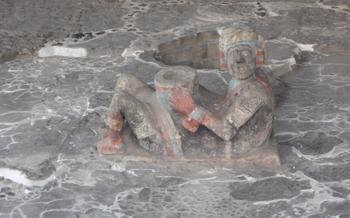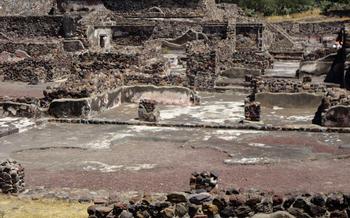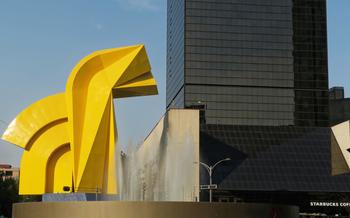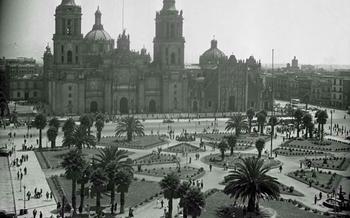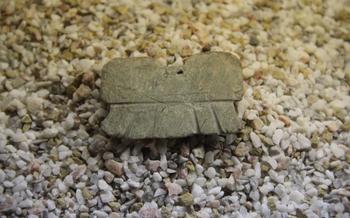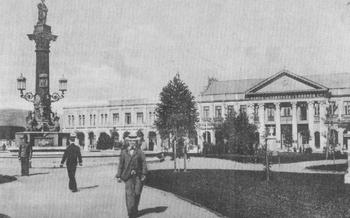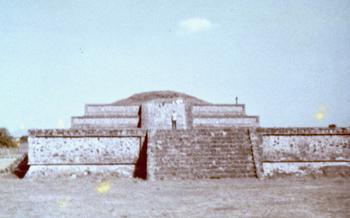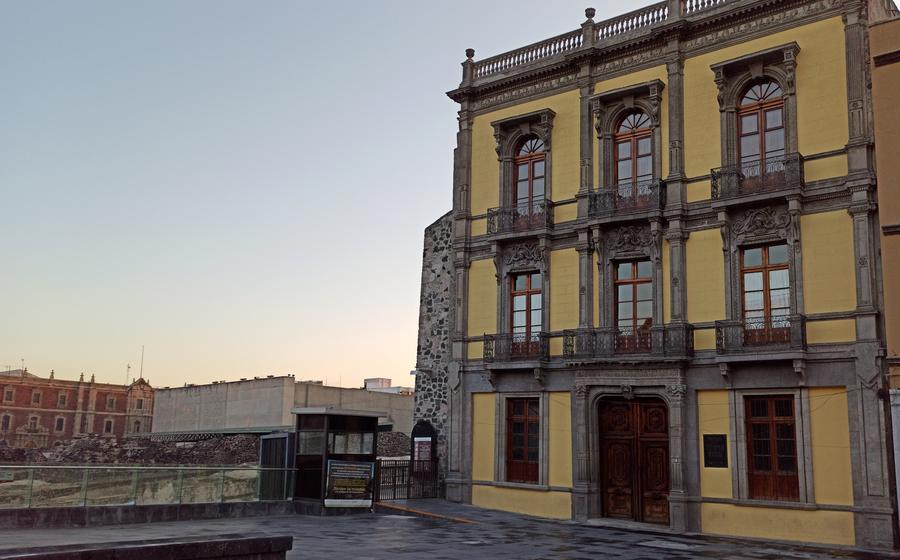
Museo del Templo Mayor
- Museum Layout and Exhibitions
- Key Artifacts and Highlights
- Cultural Context and Symbolism:
- Historical Reenactments and Performances
- Local Cuisine and Restaurants
- Shopping for Souvenirs
- Photography and Social Media
- Accessibility for Visitors with Disabilities
- Safety and Security
- Sustainability and Environmental Practices
- Insider Tip:
Museum Layout and Exhibitions
The Museo del Templo Mayor is a well-organized and informative museum that showcases the history and significance of the ancient Templo Mayor. The museum's layout is designed to take visitors on a chronological journey through the temple's history, from its construction to its destruction and rediscovery.
The museum is divided into several sections or galleries, each focusing on a different aspect of the temple's history and culture. The first section introduces visitors to the Aztec civilization and their religious beliefs, providing context for the importance of the Templo Mayor. Subsequent sections explore the temple's construction, architecture, and the rituals and ceremonies that took place within its walls.
Visitors can admire a variety of artifacts and objects related to the Templo Mayor, including sculptures, pottery, jewelry, and tools. These artifacts provide insights into the artistic, cultural, and technological achievements of the Aztec civilization. The museum also features interactive and multimedia displays that enhance the visitor experience, such as 3D models of the temple and virtual reality tours.
Key Artifacts and Highlights
Among the museum's most notable artifacts is the iconic monolith of the goddess Coyolxauhqui, discovered in 1978 during the excavations of the Templo Mayor. This colossal stone sculpture depicts the dismembered body of the moon goddess, surrounded by her severed head and limbs. The intricate carvings and symbolic elements on the monolith provide valuable insights into Aztec mythology and the significance of the Templo Mayor as a sacred site.
Another highlight is the collection of stone masks, which represent various deities and mythological figures. These masks were used in religious ceremonies and rituals, and their expressive features and intricate designs showcase the artistic skill and craftsmanship of the Aztec artisans. Visitors can also admire a variety of ceramic vessels, figurines, and jewelry that shed light on Aztec daily life, trade, and artistic traditions.
The museum also houses a replica of the Templo Mayor's main staircase, which leads to the temple's upper platform. This reconstruction allows visitors to experience the grandeur and scale of the original structure and imagine the religious processions and rituals that took place on its sacred steps.
Cultural Context and Symbolism:
The Templo Mayor held profound cultural and religious significance within Aztec society. Its architecture, sculptures, and artifacts were imbued with symbolism that reflected Aztec beliefs, mythology, and cosmology. The temple was seen as a microcosm of the universe, representing the connection between the earth and the heavens. The Templo Mayor's dual pyramids, dedicated to the gods Tlaloc and Huitzilopochtli, symbolized the duality of life and death, as well as the balance between the natural and spiritual worlds. The temple's intricate carvings and sculptures depicted mythological figures, deities, and scenes from Aztec history, serving as visual narratives that communicated religious teachings and stories. The temple's location in the heart of Tenochtitlan, the Aztec capital, further emphasized its centrality and importance in Aztec culture. Understanding the cultural and religious context of the Templo Mayor enhances visitors' appreciation of its significance and provides a deeper insight into the worldview of the ancient Aztecs.
Historical Reenactments and Performances
Immerse yourself in the vibrant history of the Templo Mayor by attending one of the captivating historical reenactments or performances that take place at the museum. These live presentations transport visitors back in time, showcasing traditional Aztec dances, rituals, and storytelling sessions. Witness the graceful movements of Aztec dancers adorned in elaborate costumes, listen to the haunting melodies of traditional music, and experience the mesmerizing power of ancient storytelling. These performances offer a unique opportunity to gain a deeper understanding of Aztec culture, traditions, and spirituality, bringing the history of the Templo Mayor to life in a truly unforgettable way. Check the museum's website or inquire at the information desk for the schedule and availability of these special performances.
Local Cuisine and Restaurants
A visit to the Museo del Templo Mayor is not complete without savoring the delectable culinary offerings of the surrounding area. The streets around the museum are lined with restaurants and eateries that serve traditional Mexican cuisine, many of which draw inspiration from Aztec flavors and ingredients.
For an authentic taste of Aztec cuisine, try the Templo Mayor Restaurant, located just a short walk from the museum. This renowned eatery specializes in pre-Hispanic dishes, using fresh, seasonal ingredients to recreate ancient recipes. Don't miss their signature dish, the "Tlaloc's Feast", a hearty stew made with a variety of meats, vegetables, and aromatic herbs.
For a more casual dining experience, head to the Mercado de San Juan, a bustling market filled with food stalls and eateries. Here, you can sample a wide range of Mexican street food, from tacos and tamales to fresh fruit and juices. Be sure to try the "huitlacoche quesadillas", made with a unique type of corn fungus that was highly prized by the Aztecs.
If you're looking for a sweet treat, indulge in the "dulces tradicionales" (traditional sweets) sold by street vendors near the museum. These handmade confections, such as "alegrías" (amaranth bars) and "cajeta" (goat's milk caramel), are a delicious way to end your visit to the Templo Mayor.
Insider Tip: For a truly immersive culinary experience, join a "food tour" that takes you to some of the best eateries in the Templo Mayor area. These tours often include visits to local markets and cooking demonstrations, allowing you to learn more about Mexican cuisine and its Aztec roots.
Shopping for Souvenirs
After delving into the history and significance of the Templo Mayor, visitors may want to take home a piece of the experience. The surrounding area offers a variety of shops and stalls selling souvenirs and handicrafts inspired by Aztec culture. From intricate replicas of Aztec artifacts to vibrant traditional textiles and handmade crafts, there's something for every taste and budget.
One popular souvenir is the iconic Templo Mayor monolith, available in various sizes and materials. Visitors can also find replicas of other Aztec sculptures, such as the Coyolxauhqui Stone or the Xiuhcoatl serpent. These replicas are often hand-carved by local artisans, ensuring their authenticity and uniqueness.
For those looking for a more personal touch, there are several stalls selling handmade crafts and textiles. Visitors can choose from colorful woven blankets, intricate silver jewelry, or hand-painted pottery, each piece carrying a story and representing the rich cultural heritage of Mexico.
Supporting local artisans by purchasing their souvenirs is not only a way to bring home a piece of the Templo Mayor but also contributes to preserving the cultural heritage of Mexico. Bargaining is acceptable and even expected at local markets, so don't be afraid to negotiate a fair price.
Photography and Social Media
Photography enthusiasts will be delighted to know that the Museo del Templo Mayor allows visitors to capture the beauty and grandeur of the exhibits through photographs. However, flash photography and tripods are prohibited to preserve the artifacts and artworks. To capture the best shots, consider using a wide-angle lens to fit the entire temple ruins into your frame. Remember to respect the privacy of other visitors and avoid taking photos of them without their consent.
Share your Templo Mayor experiences with the world on social media using the hashtag #MuseoTemploMayor. Tag the museum's official accounts (@TemploMayorMX on Twitter and @MuseoTemploMayor on Instagram) to be featured on their pages and connect with fellow history buffs. The museum occasionally runs social media campaigns or contests, so keep an eye out for opportunities to participate and win exciting prizes.
Accessibility for Visitors with Disabilities
The Museo del Templo Mayor is committed to providing an accessible and inclusive environment for visitors with disabilities. The museum features ramps and elevators that allow wheelchair users to navigate the entire facility without barriers. Wheelchair-accessible restrooms are also available for convenience. Visitors with disabilities who require assistance or accommodations, such as sign language interpretation or audio guides, are encouraged to contact the museum in advance to make arrangements. The museum staff is dedicated to ensuring that all visitors have a positive and enriching experience, regardless of their abilities.
Safety and Security
The Museo del Templo Mayor and the surrounding area are generally safe for tourists. However, as with any major city, it's essential to take standard precautions to ensure your safety and security. Be aware of your surroundings, keep your valuables secure, and avoid walking alone at night. The museum has implemented various security measures to protect visitors and their belongings, including surveillance cameras and security guards. To avoid common scams or tourist traps, be wary of individuals offering unsolicited services or tours. If you have any concerns or need assistance, don't hesitate to approach a museum staff member or local police officer.
Sustainability and Environmental Practices
The Museo del Templo Mayor is committed to sustainability and environmental responsibility. The museum has implemented several green initiatives and practices to reduce its environmental impact. These include energy-efficient lighting, water conservation measures, and recycling programs. The museum also encourages visitors to make sustainable choices, such as using public transportation or walking instead of driving, and reducing their plastic consumption. By embracing sustainability, the Museo del Templo Mayor is helping to preserve the cultural and natural heritage of the Templo Mayor for future generations.
Visitors can contribute to the museum's sustainability efforts by making responsible choices during their visit. Here are a few tips:
- Use public transportation or walk to the museum instead of driving.
- Bring your own reusable water bottle to reduce plastic waste.
- Recycle any trash or recyclables you generate during your visit.
- Be mindful of your energy consumption by turning off lights and exhibits when you are finished using them.
- Support local businesses that are committed to sustainability.
By following these tips, visitors can help the Museo del Templo Mayor achieve its sustainability goals and protect the environment for future generations.
Insider Tip:
For an unforgettable experience, plan your visit to the Museo del Templo Mayor during the annual Day of the Dead celebrations in early November. The museum hosts special events and exhibitions that bring the ancient Aztec traditions and rituals surrounding death and remembrance to life. Visitors can witness traditional altars, participate in workshops on Aztec crafts, and enjoy performances of Aztec music and dance. This is a unique opportunity to immerse yourself in the rich cultural heritage of Mexico and gain a deeper understanding of the significance of the Templo Mayor in Aztec society.
